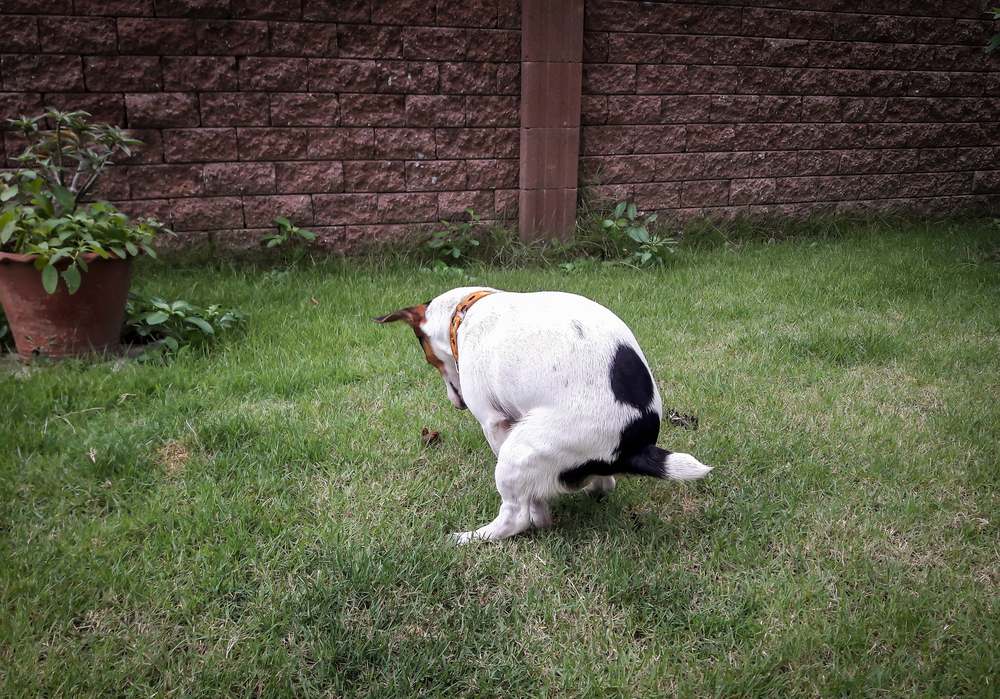Click to Skip Ahead
If you’ve got a long-haired dog, you might have experienced the joy of “dingleberries,” those little pieces of poop hanging from the hair around your dog’s butt. You know they’re not healthy, so what can you do for your dog with hard poop on their anus?
Why Is It Important to Make Sure Your Dog’s Rear End Is Clean?
First, it’s unhygienic for your dog to have stool hanging from their bottom—for them and you. Fecal material can contain microscopic parasite eggs, some of which can be transmitted to people. Roundworms and hookworms are two common zoonotic parasites in pets. Fecal material can also harbor pathogenic bacteria.
You wouldn’t want poop particles getting on your couch or bed, either. When fecal matter sits on your dog’s skin, it can irritate and lead to secondary bacterial infections. The hair can also become matted with the stool, making it uncomfortable for your dog.

Pseudocoprostasis
There is also a condition known as pseudocoprostasis, in which hair and stool mat around the rectum. This makes it impossible for your dog to defecate.
Removing Hard Stool From Your Dog’s Rectum
First, you’ll want to have disposable gloves ready. You can often get these in stores like Walmart or your local pharmacy. They usually have vinyl, nitrile, or latex gloves, which are commonly available. You should also have some pet-friendly wipes to help clean your dog’s bottom. A damp paper towel will work in a pinch, although it may be less malleable than a wipe.
Using Paper Towel or Wipes
If your dog has a small piece of stool stuck to its rear end, you can put on a pair of gloves, soften the stool with a damp paper towel or pet-safe cleansing wipe, and carefully remove it. You might need to use a comb to untangle it.
If it’s a larger piece of feces, you might need a damp towel to soften the stool and allow you to comb it out.

Bathing Your Dog
Is the stool hard or a bit large, so dampening it is inefficient? You could always bathe your dog. If your dog tolerates it, bathe it with lukewarm water and let it soak for a few minutes.
As the stool softens, you should be able to remove the feces and detangle them from the hair. Use a gentle shampoo formulated for dogs. Rinse your dog well and consider re-lathering it to ensure you get all the stool off its coat.
Clippers
If the stool doesn’t come off with gentle manipulation, consider shaving the area with a pair of clippers and a clipper guard. You should not use scissors to cut the matted hair and stool. Often, these mats are very close to the skin, and you could create a large laceration if you tremble or your pup moves.
If your dog will let you, you could trim a sanitary cut while you’re at it to trim all the hair around the rectum.
Seek Medical Help
Contact your veterinarian if you can’t remove the hard stool from your dog’s coat or think you’re dealing with pseudocoprostasis. Many vets will perform medical groomings, and many have trained groomers on staff who can help.

Preventing Stool From Getting Stuck on Your Dog
Grooming is essential to helping prevent fecal matter from sticking to your dog’s rear end. Most groomers are familiar with sanitary cuts. These hair trims should be considered for most dogs. Regular bathing also helps prevent fecal residue from building up, especially if your pup has diarrhea or stool with a soft consistency.
If your dog has diarrhea, contact your veterinarian for an exam. They can rule out intestinal parasites and prescribe medications as needed.
Frequently Asked Questions (FAQ)
What kind of shampoo should I use on my dog?
There are lots of shampoos for dogs to treat a myriad of conditions. Your veterinarian may recommend a specific shampoo if your dog is prone to skin infections.
A general rule of thumb is to avoid using human shampoos on dogs. Human shampoos are designed for a different scalp pH than your dog’s skin. Soap-based shampoos can sometimes be very drying. Fragrances can also irritate your dog’s skin and even respiratory tract.
Why should I bathe or soak my dog in lukewarm water?
Cold water can be uncomfortable for you and your pet, but hot water can be dangerous. The warmer water can contribute to your dog overheating or burning your pup’s skin. Lukewarm water gets around the potential discomfort, and it also helps keep your dog’s pores closed. Doing so helps keep your dog’s skin from drying out.
Conclusion
If your dog has feces stuck in their hair, it can seem challenging to take care of. You’ll often have success dampening the hair and gently combing it out. If not, be sure to contact your veterinarian or groomer to help get your dog’s coat and skin in tip-top shape.
Featured Image Credit: Yekatseryna Netuk, Shutterstock












